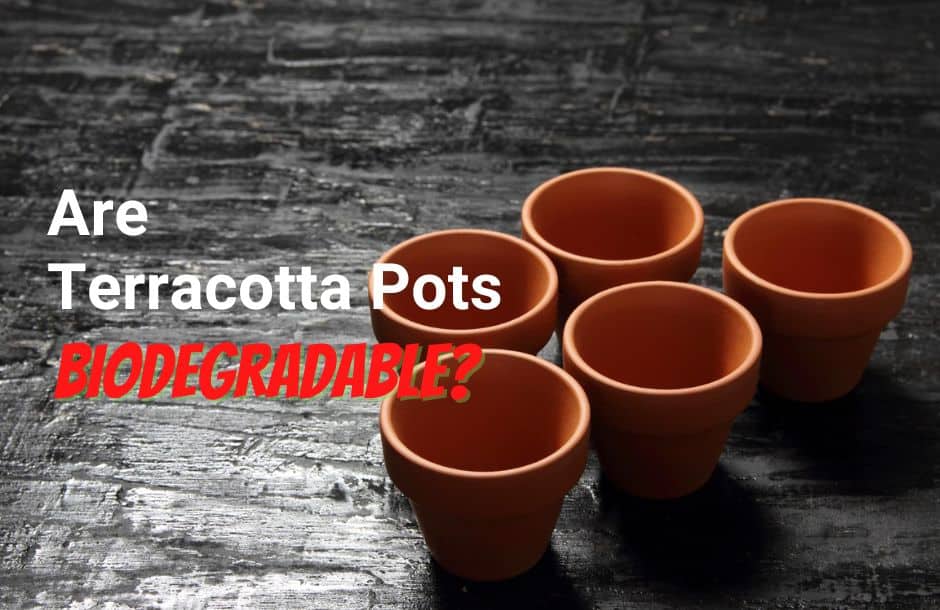Terracotta pots are made of natural clay and are therefore biodegradable. They break down over time, adding nutrients to the soil as they do so.
Are terracotta pots biodegradable?
Yes, terracotta pots are biodegradable. In fact, they are made of natural materials that can break down over time, returning to the earth. This makes them a more sustainable option for gardening than plastic pots, which can take centuries to decompose.
Terracotta pots are a popular choice for both indoor and outdoor plants. They are attractive and durable, and they can help to keep your plants healthy by allowing them to drain well and preventing root rot.
However, because they are made of natural materials, terracotta pots will eventually break down. This is not a problem, as the pots will add nutrients to the soil as they do so. However, you may want to consider replacing them every few years to ensure that your plants stay healthy.
What are terracotta pots?
Terracotta pots are made of natural clay that is found in the earth. The clay is then formed into pots of various shapes and sizes.
Once the pots are formed, they are fired in a kiln to harden them. This process gives the pots their characteristic reddish-brown color.
Terracotta pots are popular because they are attractive and durable. They are also porous, which means they can help to keep plants healthy by allowing air and water to circulate. And, because they are made of natural materials, they are biodegradable and eco-friendly.
How are clay terracotta pots made?
Clay terracotta pots are a popular choice for gardeners because they are durable, attractive, and affordable. Terracotta is a type of clay that is fired at a high temperature, typically above 1,000 degrees Fahrenheit. This causes the clay to become very hard and resistant to weathering.
There are a few different ways to make terracotta pots. The most common method is to mold the clay into the desired shape, then fire it in a kiln.
Another method is to create a pot out of a single piece of clay. This is done by forming a coil of clay, then attaching it to the previous coil. The coils are then smoothed out and the pot is fired.
Terracotta pots are often glazed to give them a different color or to make them more resistant to weathering. Glazes are made of different materials, such as lead, copper, and tin, that are melted and applied to the pot.
Terracotta pots are a popular choice for gardeners because they are durable, attractive, and affordable.
The environmental benefits of terracotta pots
Terracotta pots are made from natural clay, which is a renewable resource. They are also 100% recyclable. When you’re done with your terracotta pot, you can simply recycle it or return it to the earth by breaking it up and using it as mulch or garden compost.
Terracotta is a porous material, so it helps to regulate the temperature of the roots of your plants. In hot weather, the clay will absorb water and help to keep the roots cooler. In cold weather, the pores will help to insulate the roots and protect them from the cold.
Terracotta pots also help to improve drainage. The pores in the clay allow water to drain away from the roots of your plants, preventing them from becoming waterlogged.
All of these factors make terracotta pots an excellent choice for both indoor and outdoor plants. They are environmentally friendly, sustainable, and help to keep your plants healthy and happy.
Environmental Impacts of Terracotta Pots Production
The manufacture of terracotta pots has a significant environmental impact. The production of terracotta pots creates air pollution, water pollution, and soil contamination.
Air Pollution
The manufacture of terracotta pots creates air pollution. The most harmful pollutant emitted from the production of terracotta pots is particulate matter. Particulate matter consists of small particles of dust, soot, and smoke. These particles can cause respiratory problems, heart disease, and premature death.
Water Pollution
The manufacture of terracotta pots also creates water pollution. The most common type of water pollution caused by the production of terracotta pots is chemical pollution. Chemicals used in the production of terracotta pots can pollute water bodies, making them unsafe for human use.
Soil Contamination
The production of terracotta pots also causes soil contamination. Chemicals used in the production of terracotta pots can leach into the soil, contaminating it. This can make the soil unsuitable for agriculture or human habitation.
The pros and cons of using terracotta pots
Terracotta pots are a popular choice for indoor and outdoor plants, but there are some pros and cons to using them.
One advantage of terracotta pots is that they are porous, which means that they can help to regulate the amount of water that your plants receive.
This can be helpful in preventing overwatering, which can be a problem with other types of pots. Another advantage of terracotta pots is that they are relatively inexpensive.
However, there are some disadvantages to using terracotta pots as well.
One is that they are quite fragile and can easily be broken.
Another is that they can absorb nutrients from the soil, which can be beneficial for some plants but not others.
Finally, terracotta pots can be quite heavy, making them difficult to move around.
How to Recycle terracotta pots
If you’re like most gardeners, you have a few terra-cotta pots lying around. Maybe you’ve used them to pot up a few plants, and now you have no more use for them.
Or maybe you’ve had a pot break, and you don’t know what to do with the shards.
Terracotta pots can be recycled into a variety of new objects, including garden art, bird houses, and even new pots.
One way is to use them to grow plants in. You can either plant the plants directly in the pot, or you can put a pot inside a pot to create a planter.
Another way to use recycled terracotta pots is to use them as a way to organize your plants. You can group plants together by color, size, or type.
You can also use recycled terracotta pots to create a garden border. Simply place a few pots around the edge of your garden to add some interest.
If you have any broken pots, you can use them to create a mosaic garden path. Simply crush the pot and then use mortar to attach it to a base such as concrete or stone.
You can also use recycled terracotta pots to make a garden sculpture.
Recycling terra-cotta pots is a great way to give new life to old pots, and it also helps reduce waste. So next time you have a few terra-cotta pots lying around, don’t throw them away – recycle them into something new and beautiful.
FREQUENTLY ASKED QUESTIONS
Are clay pots compostable?
Clay pots are made of natural materials and are therefore compostable. They are a great option for container gardening because they allow for good drainage and airflow. When composting clay pots, make sure to crush them so they can break down more easily.
Are clay pots eco-friendly?
The answer to this question is yes, they are! Clay pots are made from natural materials and can be recycled or reused after they are no longer needed.
Clay pots are made from natural materials. This means that they are biodegradable and can be recycled or reused after they are no longer needed. This makes them eco-friendly, as it reduces the amount of waste that is produced.
Clay pots are also very durable. This means that they can be used multiple times, which reduces the amount of waste that is produced. When they are no longer needed, they can be recycled or reused, which further reduces their environmental impact.
Clay pots are a great choice for eco-friendly gardeners. If you are looking for a sustainable way to garden, then clay pots are a good option.
Want to know more about various BIODEGRADABLE products & materials?
Check out our latest articles and tips for enjoying your simple and sustainable life.
key takeaways
Terracotta pots are biodegradable and sustainable products for gardening. They are made of natural materials that can be broken down by the elements, making them a more environmentally friendly option than plastic pots. In addition, terracotta pots help to regulate the soil’s temperature, which can be beneficial for plants.

